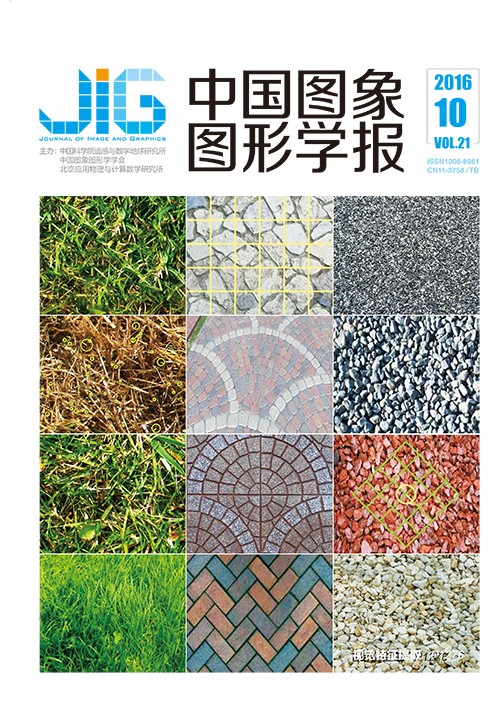
图像局部纹理特性的静电力触觉渲染
摘 要
目的 触摸触觉设备感知物体时,需要实现视觉-力触觉同步反馈,其中图像-力触觉反馈难点在于再现更真实的纹理触感的触觉渲染过程。本文提出了一种基于图像局部纹理特征的静电力触觉渲染模型,实现了更加清晰、触感真实的图像纹理的静电力触觉反馈。方法 首先,采用局部傅里叶变换方法强化局部纹理特征,提取傅里叶变换系数分离出表征形状和局部纹理、边缘的频域分量。其次,对局部纹理特征进行力触觉渲染,建立局部纹理特征与驱动信号的映射模型,采用比例模型将局部纹理特征值转化为同等级的静电力表达。最后,根据静电力与驱动信号的心理学模型,由局部纹理特征控制不同驱动信号的输出产生静电力触觉。结果 进行纹理触觉对比感知实验验证算法有效性,62.5%的实验参与者偏爱基于图像局部纹理的触觉渲染算法反馈的纹理触感,本文算法可以模拟多种图像的纹理、边缘的触感。结论 算法在频域分离图像局部纹理、边缘和形状特征,建立纹理-力触觉渲染模型,针对大多数图片可以有效地增强纹理触感,提升触觉再现交互技术的沉浸感。
关键词
Electrostatic tactile rendering of local image texture feature
Wang Tingting, Chen Jian, Sun Xiaoying(College of Communications Engineering, Jilin University, Changchun 130022, China) Abstract
Objective Image shape perception is the key aspect of electrostatic tactile interaction in fields of virtual reality and human-computer interaction. This approach is widely applied in phones and tablets and has good portability. Synchronous visual-tactile feedback should be rendered to achieve tactile simulation of image texture when people use their devices to interact with virtual environments. The goal of electrostatic tactile rendering is to develop tactile rendering algorithms for images that can provide realistic and various tactile sensations to consumers. Tactile rendering techniques for details of image texture directly affect the effectiveness of electrostatic tactile feedback. To provide high clarity and various tactile sensations for an electrostatic tactile system, a new rendering model based on local texture feature is proposed. Method First, we utilize local Fourier transform to enhance texture detail features. Frequency domain components of shape and local texture, which are edge features by Fourier coefficients, are separated. Local texture properties are characterized with different Fourier coefficients. Then, to realize local texture rendering with tactile devices, a mapping model between local texture feature and driving signal is set up. Local texture features are scaled to correspond to the same level of electrostatic force levels. Local Fourier coefficients of texture are mapped to lateral friction forces. This mapping model builds a new relationship between texture feature and electrostatic tactile, and provides a basis to generate different tactile sensations for different images. Finally, we can control actuation signal magnitudes to generate different electrostatic tactile intensities according to psychological model of electrostatic force and actuation signal. This psychological model relates the perceived force to the controlled actuated voltage applied to the self-developed electrostatic tactile device. The model displays various tactile feelings according to a local texture feature that is touched. Result We conduct contrastive experiments of tactile texture perception to validate the electrostatic tactile rendering algorithm. Experiments results indicate that 62.5% of the participants preferred local texture force feedback than other gradient force feedbacks. Participants thought that texture perception, provided by electrostatic tactile rendering algorithm of local texture, were clearer than the electrostatic tactile-rendering algorithm of gradients. The local texture-rendering algorithm can also display fine texture details. With clearer texture, highly delicate electrostatic tactile sensations are perceived by users. This rendering model can simulate feelings of texture and edge for most images. Conclusion This study efficiently enhances local texture features by separating texture and shape features in the frequency domain for most images. A mapping model of electrostatic tactile and local texture features are used to ensure realistic tactile perception feedback. This paper presents a generalized tactile rendering model to display textures for the electrostatic tactile system. Interactive virtual environment immersion can be effectively improved by local texture tactile interactive technology.
Keywords
|



 中国图象图形学报 │ 京ICP备05080539号-4 │ 本系统由
中国图象图形学报 │ 京ICP备05080539号-4 │ 本系统由